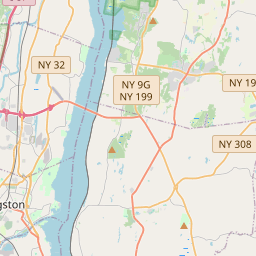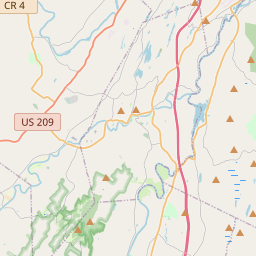Sojourner Truth
Historical marker location:
Port Ewen, New York
( Marker is at the intersection of Broadway (U.S. 9W) and Salem Street, on the right when traveling south on Broadway.)













© OpenStreetMap contributors
Daughter of Esopus
Loading...
Searching for other points of interest within 3 miles of this location.The Hudson River School of painting, which was a 19th-century art movement that focused on landscapes and the natural world, was founded in New York State. Some of its most famous artists, such as Thomas Cole and Frederic Edwin Church, lived and worked in the Hudson River Valley.
About Ulster County
Ulster County Timeline
Ulster County, located in the state of New York, has a rich and diverse history that spans several centuries. The area was originally inhabited by the Lenape Native American tribe before European settlers arrived in the 17th century. In 1614, the first European exploration of the region took place when Dutch navigator Hendrick Christiaensen sailed up the Hudson River.
In 1652, the Dutch established the town of Wiltwyck, which would later become Kingston, the county seat. The settlement quickly grew as a center for trade between the Dutch and local Native American tribes. However, the area was also marked by conflict, with tensions between the Dutch and British escalating.
During the American Revolution, Ulster County played a significant role. The area had a strong presence of patriots, and Kingston briefly served as the first capital of New York State. In 1777, the county was a target of a British invasion. The Burning of Kingston occurred in October of that year, leaving the city devastated.
As the county developed in the 19th century, it became a major hub for agriculture and manufacturing. The development of the Delaware and Hudson Canal and the arrival of the railroad further boosted the local economy. A diverse range of industries emerged, including tanning, textile manufacturing, and brick making, which contributed to the county's growth and prosperity.
In the 20th century, Ulster County witnessed significant changes. It transformed into a popular tourist destination, known for its natural beauty, outdoor recreation, and historic sites. The iconic Woodstock Music Festival took place in Bethel, just outside of Ulster County, in 1969, leaving a lasting cultural impact on the region. Today, Ulster County continues to thrive as a vibrant community, preserving its history while embracing innovation and progress.
In 1652, the Dutch established the town of Wiltwyck, which would later become Kingston, the county seat. The settlement quickly grew as a center for trade between the Dutch and local Native American tribes. However, the area was also marked by conflict, with tensions between the Dutch and British escalating.
During the American Revolution, Ulster County played a significant role. The area had a strong presence of patriots, and Kingston briefly served as the first capital of New York State. In 1777, the county was a target of a British invasion. The Burning of Kingston occurred in October of that year, leaving the city devastated.
As the county developed in the 19th century, it became a major hub for agriculture and manufacturing. The development of the Delaware and Hudson Canal and the arrival of the railroad further boosted the local economy. A diverse range of industries emerged, including tanning, textile manufacturing, and brick making, which contributed to the county's growth and prosperity.
In the 20th century, Ulster County witnessed significant changes. It transformed into a popular tourist destination, known for its natural beauty, outdoor recreation, and historic sites. The iconic Woodstock Music Festival took place in Bethel, just outside of Ulster County, in 1969, leaving a lasting cultural impact on the region. Today, Ulster County continues to thrive as a vibrant community, preserving its history while embracing innovation and progress.
Ulster County Timeline
This timeline provides a condensed summary of the historical journey of Ulster County, New York.
- 1600s: The region of Ulster County is inhabited by the Lenape Native American tribe.
- 1609: Henry Hudson, an English explorer, sails up the Hudson River and claims the land for the Dutch.
- 1664: The British take control of the area from the Dutch and name it Ulster County.
- 1714: The county becomes part of the newly formed colony of New York.
- 1777-1783: Ulster County contributes actively to the American Revolutionary War.
- 1797: Kingston is established as the county seat.
- 1800s: The county experiences growth and development with the expansion of the Erie Canal and the arrival of the railroad.
- 1869: The Shawangunk Ridge is designated as a national forest.
- 1907: The Catskill Forest Preserve is established, protecting much of the county's natural beauty.
- 1969: The Woodstock Music Festival takes place in Bethel, attracting hundreds of thousands of attendees.
- 1987: The Walkway Over the Hudson, a pedestrian bridge, opens as the longest elevated park in the world.